
How to Use Step Up Boost Liion Battery Charger Board DDTCCRUB 3S2A: Examples, Pinouts, and Specs
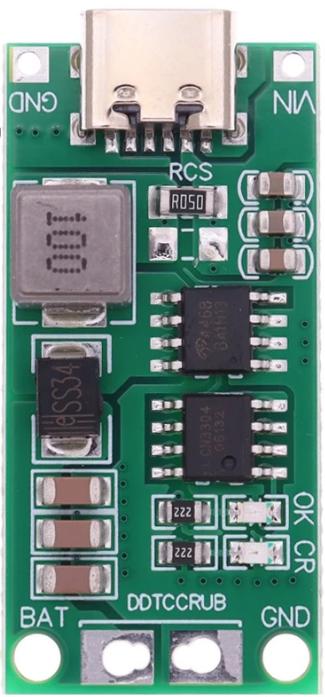
 Design with Step Up Boost Liion Battery Charger Board DDTCCRUB 3S2A in Cirkit Designer
Design with Step Up Boost Liion Battery Charger Board DDTCCRUB 3S2A in Cirkit DesignerIntroduction
The Step Up Boost Li-ion Battery Charger Board DDTCCRUB 3S2A is a specialized circuit board designed to charge lithium-ion batteries. It is capable of boosting voltage to support 3 cells in series (3S) with a maximum output current of 2A. This component is ideal for applications requiring efficient charging and voltage regulation for 3S battery packs, such as portable electronics, DIY power banks, and robotics.
Explore Projects Built with Step Up Boost Liion Battery Charger Board DDTCCRUB 3S2A
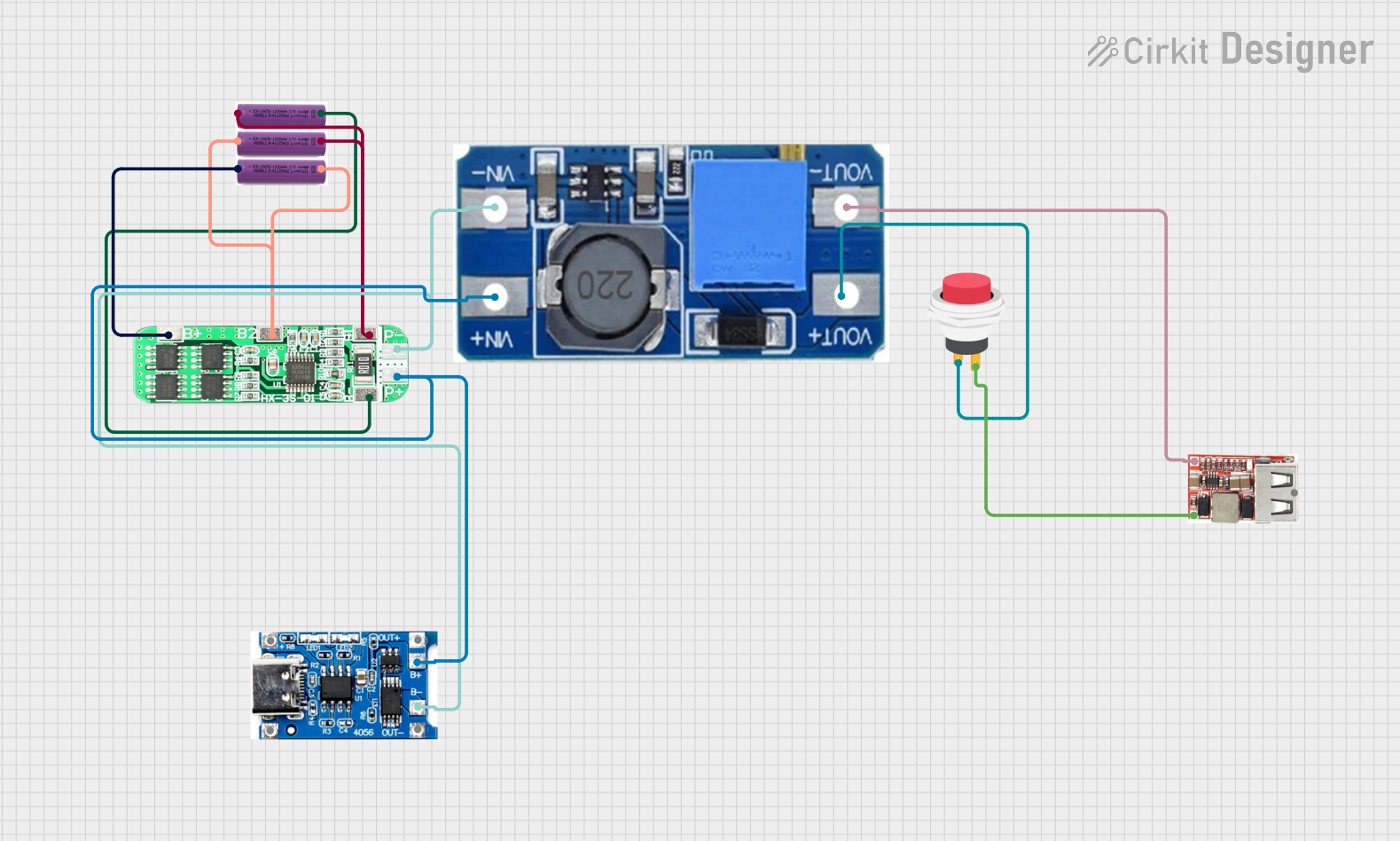
 Open Project in Cirkit Designer
Open Project in Cirkit Designer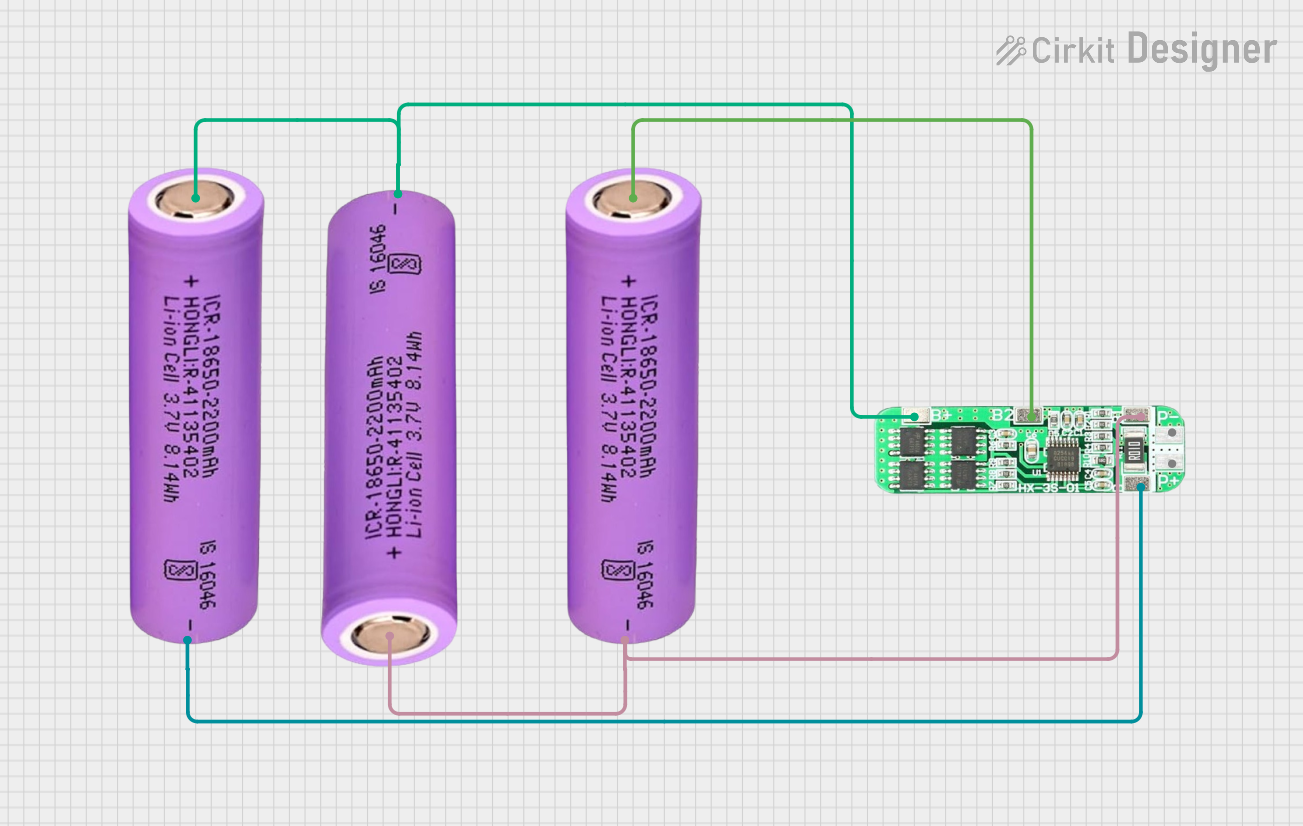
 Open Project in Cirkit Designer
Open Project in Cirkit Designer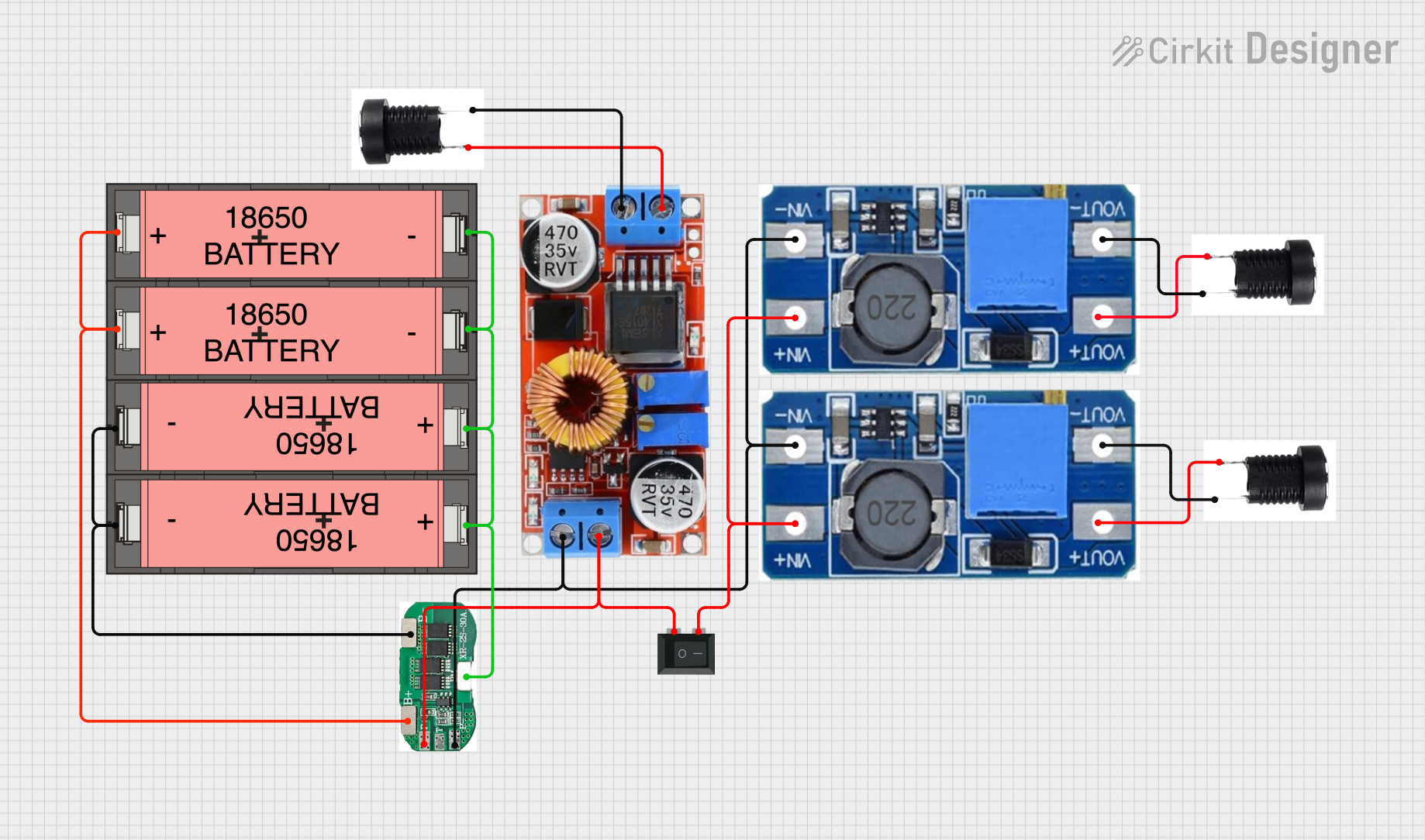
 Open Project in Cirkit Designer
Open Project in Cirkit Designer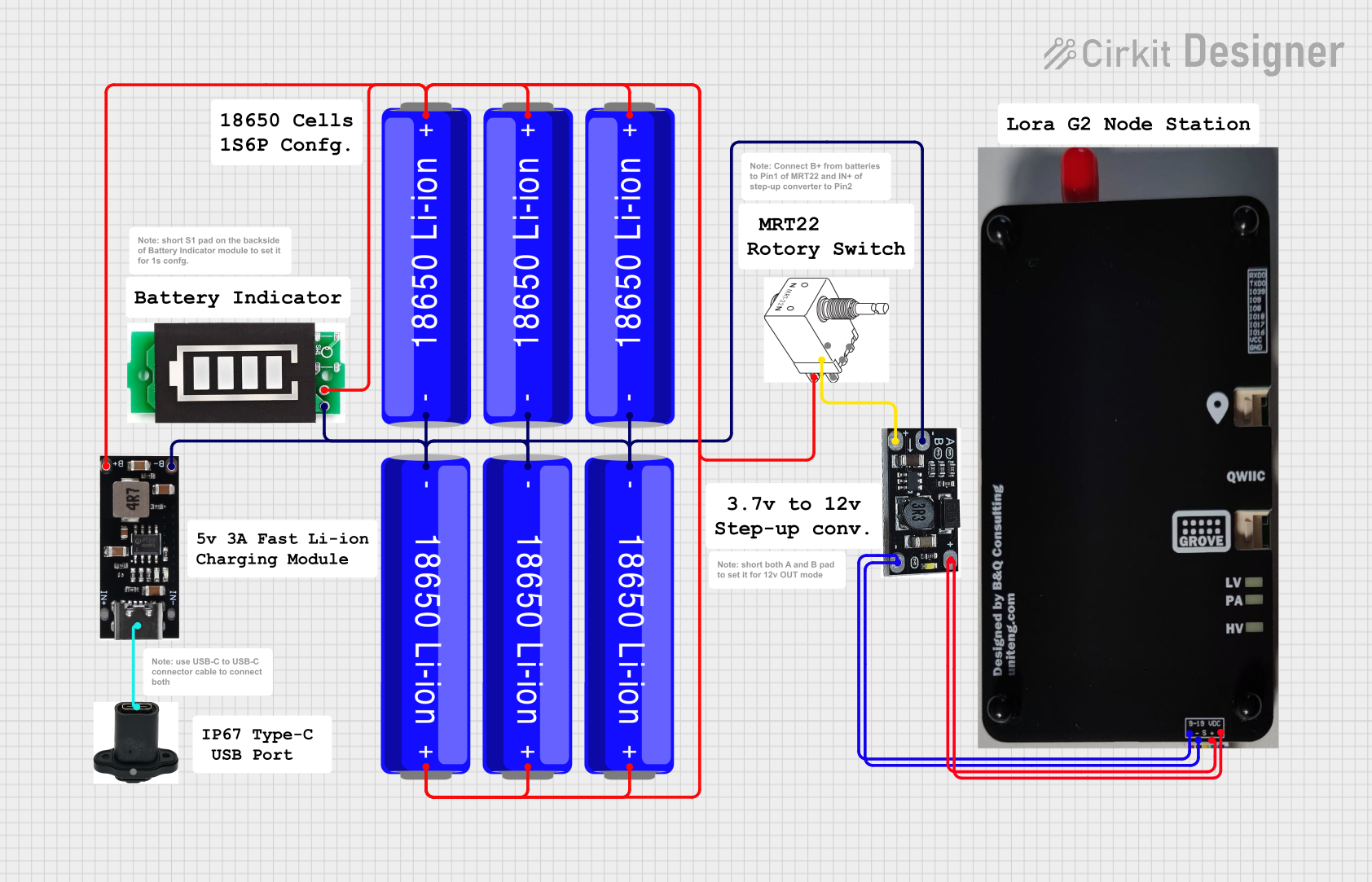
 Open Project in Cirkit Designer
Open Project in Cirkit DesignerExplore Projects Built with Step Up Boost Liion Battery Charger Board DDTCCRUB 3S2A

 Open Project in Cirkit Designer
Open Project in Cirkit Designer
 Open Project in Cirkit Designer
Open Project in Cirkit Designer
 Open Project in Cirkit Designer
Open Project in Cirkit Designer
 Open Project in Cirkit Designer
Open Project in Cirkit DesignerCommon Applications and Use Cases
- Charging 3S lithium-ion battery packs in portable devices
- Powering small robotics and drones
- DIY power banks and backup power systems
- Applications requiring stable voltage boosting for 3-cell battery configurations
Technical Specifications
The following table outlines the key technical details of the Step Up Boost Li-ion Battery Charger Board DDTCCRUB 3S2A:
| Parameter | Value |
|---|---|
| Input Voltage Range | 5V to 12V |
| Output Voltage | 12.6V (for 3S battery packs) |
| Maximum Output Current | 2A |
| Charging Method | Constant Current/Constant Voltage |
| Battery Configuration | 3S (3 cells in series) |
| Efficiency | Up to 92% |
| Dimensions | 50mm x 25mm x 10mm |
Pin Configuration and Descriptions
The board features the following pins and connectors:
| Pin/Connector | Description |
|---|---|
| VIN+ | Positive input voltage terminal (5V to 12V) |
| VIN- | Negative input voltage terminal (ground) |
| B+ | Positive terminal for the 3S lithium-ion battery pack |
| B- | Negative terminal for the 3S lithium-ion battery pack |
| OUT+ | Positive output terminal (boosted voltage, 12.6V) |
| OUT- | Negative output terminal (ground) |
| LED Indicators | Status LEDs for charging (red) and fully charged (green) |
Usage Instructions
How to Use the Component in a Circuit
Connect the Input Voltage:
- Connect a DC power source (5V to 12V) to the
VIN+andVIN-terminals. - Ensure the input voltage is within the specified range to avoid damage.
- Connect a DC power source (5V to 12V) to the
Connect the Battery Pack:
- Attach the positive terminal of the 3S lithium-ion battery pack to the
B+pin. - Attach the negative terminal of the battery pack to the
B-pin.
- Attach the positive terminal of the 3S lithium-ion battery pack to the
Connect the Output Load (Optional):
- If you need to power an external load, connect it to the
OUT+andOUT-terminals. - Ensure the load does not exceed the maximum output current of 2A.
- If you need to power an external load, connect it to the
Monitor the Charging Status:
- Observe the LED indicators:
- Red LED: Charging in progress.
- Green LED: Charging complete.
- Observe the LED indicators:
Important Considerations and Best Practices
- Input Voltage: Always ensure the input voltage is within the 5V to 12V range. Exceeding this range may damage the board.
- Battery Compatibility: Use only 3S lithium-ion battery packs. Connecting incompatible batteries may result in improper charging or damage.
- Heat Dissipation: The board may heat up during operation. Ensure proper ventilation or use a heatsink if necessary.
- Polarity: Double-check all connections for correct polarity to prevent short circuits or damage.
Example: Using with an Arduino UNO
The Step Up Boost Li-ion Battery Charger Board can be used to power an Arduino UNO via its VIN pin. Below is an example code to monitor the battery voltage using the Arduino's analog input:
// Example code to monitor battery voltage using Arduino UNO
const int batteryPin = A0; // Analog pin connected to battery output
const float voltageDividerRatio = 4.2; // Adjust based on resistor values used
void setup() {
Serial.begin(9600); // Initialize serial communication
pinMode(batteryPin, INPUT); // Set the battery pin as input
}
void loop() {
int rawValue = analogRead(batteryPin); // Read the analog value
float batteryVoltage = (rawValue * 5.0 / 1023.0) * voltageDividerRatio;
// Print the battery voltage to the Serial Monitor
Serial.print("Battery Voltage: ");
Serial.print(batteryVoltage);
Serial.println(" V");
delay(1000); // Wait for 1 second before the next reading
}
Note: Use a voltage divider circuit to scale down the battery voltage to a safe range for the Arduino's analog input (0-5V). Adjust the
voltageDividerRatiobased on the resistor values used.
Troubleshooting and FAQs
Common Issues and Solutions
Board Not Powering On:
- Cause: Input voltage is too low or not connected properly.
- Solution: Verify the input voltage is within the 5V to 12V range and check the connections.
Battery Not Charging:
- Cause: Incorrect battery connection or incompatible battery type.
- Solution: Ensure the battery is a 3S lithium-ion pack and check the polarity of the connections.
Excessive Heat:
- Cause: High input current or insufficient ventilation.
- Solution: Reduce the input current or improve heat dissipation with a heatsink or fan.
LED Indicators Not Working:
- Cause: Faulty LEDs or incorrect wiring.
- Solution: Check the LED connections and replace faulty LEDs if necessary.
FAQs
Can I use this board with a 2S or 4S battery pack?
- No, this board is specifically designed for 3S lithium-ion battery packs.
What happens if the input voltage exceeds 12V?
- Exceeding 12V may damage the board. Always use a regulated power supply within the specified range.
Can I use this board to power devices directly?
- Yes, you can connect a load to the
OUT+andOUT-terminals, but ensure the load does not exceed 2A.
- Yes, you can connect a load to the
Is reverse polarity protection included?
- No, the board does not have reverse polarity protection. Double-check all connections before powering on.
This documentation provides a comprehensive guide to using the Step Up Boost Li-ion Battery Charger Board DDTCCRUB 3S2A effectively and safely.